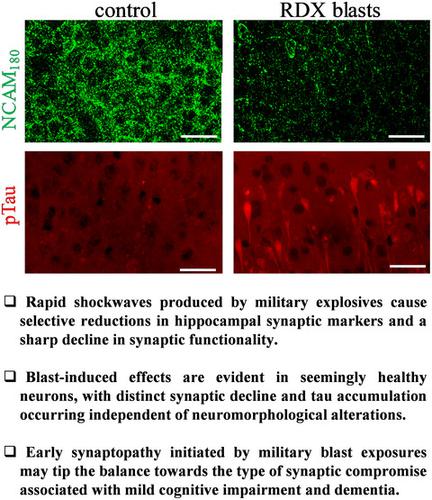当前位置:
X-MOL 学术
›
Brain Pathol.
›
论文详情
Our official English website, www.x-mol.net, welcomes your feedback! (Note: you will need to create a separate account there.)
Distinct and dementia-related synaptopathy in the hippocampus after military blast exposures
Brain Pathology ( IF 6.4 ) Pub Date : 2021-02-24 , DOI: 10.1111/bpa.12936 Michael F Almeida 1 , Thuvan Piehler 2 , Kelly E Carstens 3 , Meilan Zhao 3 , Mahsa Samadi 3 , Serena M Dudek 3 , Christopher J Norton 1 , Catherine M Parisian 1 , Karen L G Farizatto 1 , Ben A Bahr 1
Brain Pathology ( IF 6.4 ) Pub Date : 2021-02-24 , DOI: 10.1111/bpa.12936 Michael F Almeida 1 , Thuvan Piehler 2 , Kelly E Carstens 3 , Meilan Zhao 3 , Mahsa Samadi 3 , Serena M Dudek 3 , Christopher J Norton 1 , Catherine M Parisian 1 , Karen L G Farizatto 1 , Ben A Bahr 1
Affiliation

|
Explosive shockwaves, and other types of blast exposures, are linked to injuries commonly associated with military service and to an increased risk for the onset of dementia. Neurological complications following a blast injury, including depression, anxiety, and memory problems, often persist even when brain damage is undetectable. Here, hippocampal explants were exposed to the explosive 1,3,5-trinitro-1,3,5-triazinane (RDX) to identify indicators of blast-induced changes within important neuronal circuitries. Highly controlled detonations of small, 1.7-gram RDX spherical charges reduced synaptic markers known to be downregulated in cognitive disorders, but without causing overt neuronal loss or astroglial responses. In the absence of neuromorphological alterations, levels of synaptophysin, GluA1, and synapsin IIb were significantly diminished within 24 hr, and these synaptic components exhibited progressive reductions following blast exposure as compared to their stable maintenance in control explants. In contrast, labeling of the synapsin IIa isoform remained unaltered, while neuropilar staining of other markers decreased, including synapsin IIb and neural cell adhesion molecule (NCAM) isoforms, along with evidence of NCAM proteolytic breakdown. NCAM180 displayed a distinct decline after the RDX blasts, whereas NCAM140 and NCAM120 exhibited smaller or no deterioration, respectively. Interestingly, the extent of synaptic marker reduction correlated with AT8-positive tau levels, with tau pathology stochastically found in CA1 neurons and their dendrites. The decline in synaptic components was also reflected in the size of evoked postsynaptic currents recorded from CA1 pyramidals, which exhibited a severe and selective reduction. The identified indicators of blast-mediated synaptopathy point to the need for early biomarkers of explosives altering synaptic integrity with links to dementia risk, to advance strategies for both cognitive health and therapeutic monitoring.
中文翻译:

军事爆炸暴露后海马中不同的和痴呆相关的突触病
爆炸性冲击波和其他类型的爆炸暴露与通常与兵役相关的伤害以及痴呆症发病风险增加有关。爆炸伤后的神经系统并发症,包括抑郁、焦虑和记忆问题,即使在无法检测到脑损伤时也经常持续存在。在这里,海马外植体暴露于爆炸性的 1,3,5-trinitro-1,3,5-triazinane (RDX) 以识别重要神经元回路内爆炸引起的变化的指标。高度控制的小型 1.7 克 RDX 球形电荷的爆炸减少了已知在认知障碍中被下调的突触标记,但不会导致明显的神经元损失或星形胶质细胞反应。在没有神经形态学改变的情况下,突触素 GluA1 的水平,和突触蛋白 IIb 在 24 小时内显着减少,与它们在对照外植体中的稳定维持相比,这些突触成分在爆炸暴露后表现出逐渐减少。相比之下,突触蛋白 IIa 亚型的标记保持不变,而其他标志物的神经毛细胞染色减少,包括突触蛋白 IIb 和神经细胞粘附分子 (NCAM) 亚型,以及 NCAM 蛋白水解分解的证据。NCAM 以及 NCAM 蛋白水解分解的证据。NCAM 以及 NCAM 蛋白水解分解的证据。NCAM180在 RDX 爆炸后显示出明显的下降,而 NCAM 140和 NCAM 120分别表现出较小或没有恶化。有趣的是,突触标记减少的程度与 AT8 阳性 tau 水平相关,在 CA1 神经元及其树突中随机发现 tau 病理学。突触成分的减少也反映在 CA1 锥体记录的诱发突触后电流的大小上,表现出严重和选择性的减少。已确定的爆炸介导的突触病变指标表明,需要爆炸物的早期生物标志物改变与痴呆风险相关的突触完整性,以推进认知健康和治疗监测的策略。
更新日期:2021-02-24
中文翻译:

军事爆炸暴露后海马中不同的和痴呆相关的突触病
爆炸性冲击波和其他类型的爆炸暴露与通常与兵役相关的伤害以及痴呆症发病风险增加有关。爆炸伤后的神经系统并发症,包括抑郁、焦虑和记忆问题,即使在无法检测到脑损伤时也经常持续存在。在这里,海马外植体暴露于爆炸性的 1,3,5-trinitro-1,3,5-triazinane (RDX) 以识别重要神经元回路内爆炸引起的变化的指标。高度控制的小型 1.7 克 RDX 球形电荷的爆炸减少了已知在认知障碍中被下调的突触标记,但不会导致明显的神经元损失或星形胶质细胞反应。在没有神经形态学改变的情况下,突触素 GluA1 的水平,和突触蛋白 IIb 在 24 小时内显着减少,与它们在对照外植体中的稳定维持相比,这些突触成分在爆炸暴露后表现出逐渐减少。相比之下,突触蛋白 IIa 亚型的标记保持不变,而其他标志物的神经毛细胞染色减少,包括突触蛋白 IIb 和神经细胞粘附分子 (NCAM) 亚型,以及 NCAM 蛋白水解分解的证据。NCAM 以及 NCAM 蛋白水解分解的证据。NCAM 以及 NCAM 蛋白水解分解的证据。NCAM180在 RDX 爆炸后显示出明显的下降,而 NCAM 140和 NCAM 120分别表现出较小或没有恶化。有趣的是,突触标记减少的程度与 AT8 阳性 tau 水平相关,在 CA1 神经元及其树突中随机发现 tau 病理学。突触成分的减少也反映在 CA1 锥体记录的诱发突触后电流的大小上,表现出严重和选择性的减少。已确定的爆炸介导的突触病变指标表明,需要爆炸物的早期生物标志物改变与痴呆风险相关的突触完整性,以推进认知健康和治疗监测的策略。



























 京公网安备 11010802027423号
京公网安备 11010802027423号